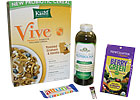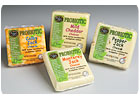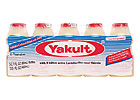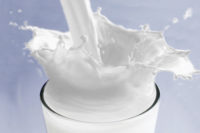

Tokyo-based consumer products company Yakult Honsha Co., recognized that the time [2007] was finally right to make its world-leading, daily-dose beverage Yakult available to all of America. “More than 25 million people in 30 countries around the world enjoy Yakult on a daily basis. We hope that Americans will also incorporate our delicious product into their diets in pursuit of a healthy lifestyle,” says Teruo Tabuchi, vice president and COO of Torrance, Calif.-based Yakult U.S.A. Inc.
Prebiotic fibers are also gaining the attention of Americans. Here’s their claim to fame: prebiotic fibers are not food for humans; they are food for intestinal bacteria-specifically the good guys, the probiotics.
With so much activity in the area of prebiotics and probiotics, Dairy Foods conducted a roundtable with leaders in the business to see what they have to say about the future of the industry. Here are their comments:
Dairy Foods: The terms prebiotics and probiotics are becoming more familiar, even in mainstream-America consumer press. What’s going on?
Munteanu: Because consumers are increasingly looking to maintain and improve their well-being through dietary habits, the media has responded by highlighting novel ingredients in better-for-you foods.
Curic-Bawden: For long, fermented dairy products with probiotics have been part of the diet in Europe and Asia. Some health-conscious U.S. consumers knew of the benefits of live and active cultures, as exemplified in the fact that acidophilus milk has been available in Southern states for more than three decades. In recent years, there has been a great deal of consumer education through different forms of advertisement, as well as coordinated communication to nutritionists, doctors and nurses.
Young: Both prebiotic- and probiotic-containing products are supported with years of sound science, and this encourages novel, new nutritional approaches and food forms to manage obesity, diabetes and other maladies. The message has hit a nerve in both scientific and consumer communities, and this is a good thing for consumers, as they are hearing the message again and again.
Steele: Already well-known in the dietary supplements market, probiotics have indeed registered record growth in the food market for the past two years. Dairy applications are the most represented category as they are the ideal vehicle for probiotics, but not the only delivery vehicle. Dairy manufacturers have been very active in communicating about their new probiotic products and their related health benefits. Dannon started the show, and numerous other manufacturers followed.

Turowski: Indeed, Dannon used a simple message to convey a complex issue to the general public in a way that it is easy to understand.
Dairy Foods: What made 2007 the year to have prebiotics and probiotics go mainstream?
Shomenta: A combination of factors made 2007 the year. For starters, there is the burgeoning baby boomer population, and the fact that the prevalence of gastrointestinal disorders is at an all time high. After Danone brought Activia to U.S. grocery aisles, the media could not resist putting the product and the concept in the spotlight. This helped tremendously, along with all the media attention given to increased health care costs. Consumers are embracing the idea of foods and beverages that deliver functional benefits beyond nutrition.
Sanders: Convergence of efficacy science, tasty products, communications with consumers, communications with healthcare professionals and communications with mainstream media have made 2007 “the year.”
Dairy Foods: What prebiotics or probiotics does your company supply?
Munteanu: Prebiotics such as NutraFlora short-chain fructooligosaccharides (scFOS) from GTC Nutrition nourish the growth of probiotics and contribute to health in a number of ways. The first way is through competitive exclusion. By providing a selective growth medium to the colon and nourishing probiotic bacteria, including Lactobacilli and Bifidobacteria, NutraFlora helps to crowd out less beneficial bacteria, which can otherwise overgrow and cause problems. When comparing prebiotic fiber ingredients, glucose termination and short-chain length are extremely important considerations to the fermentation profile and ingredient functionality. The chemical structure and chain length of a prebiotic will determine how easily it can be utilized by probiotic bacteria. NutraFlora scFOS is a specific, defined mixture of glucose-terminated fructose chains with a maximum chain length of five units, and 95% pure active prebiotic. It is derived from cane or beet sugar by a natural fermentation process and has more than 200 scientific studies supporting its health benefits.
Niba: National Starch Food Innovation markets Nutriose, a prebiotic soluble fiber. It is a corn- or wheat-based agglomerated dextrin with excellent functionality and stability in all food applications, but particularly in high-moisture formulations such as dairy products and dairy beverages. Nutriose is 85% fiber with only two calories per gram. It is extremely stable to pasteurization, low pH and freezing. In addition to its functionality as a fiber, Nutriose can be used in sugar- and fat-reduced dairy products by compensating for the loss of mouthfeel and texture. As a prebiotic, it is fermented by a wide range of bacteria in the colon, producing beneficial short-chain fatty acids such as acetate and propionate. In addition, the fermentation of Nutriose facilitates the growth of beneficial probiotic bacteria, while at the same time depleting pathogenic harmful bacteria. Because Nutriose is fermented slowly over the length of the colon, gases released by the fermentation process are absorbed by the colonocytes without causing discomfort to the consumer.

Turowski: Sensus America is the supplier of Frutafit and Frutalose inulin ingredients, both of which are sourced from chicory root. The Sensus line of inulin ingredients not only provides prebiotic fiber, it offers a host of functional properties ranging from fat and sugar replacement to flavor enhancement. A recently published clinical study conducted on healthy adults shows that Frutafit inulin provides a prebiotic effect at a dose of 5g per day. This study was published in the European Journal of Clinical Nutrition (January 2007).
O’Neill: Derived from chicory, Orafti’s Beneo inulin and oligofructose ingredients offer an impressive range of functional benefits to food, beverage and nutritional supplement manufacturers, not the least of which are their effects as prebiotic fibers. Specifically, Beneo Synergy 1 was evaluated in a one-year clinical trial at the Baylor College of Medicine in Texas in a study funded by the National Institute of Health. This study is the basis for our increased calcium absorption, increased bone mineral density and lowered body mass index structure-function claims. The fact is that all fibers are not created equal and many fibers function physiologically in different ways. We know what Beneo Synergy 1 is capable of doing.
Shomenta: A recent clinical study conducted by Cosucra Groupe Warcoing indicates that Cosucra’s prebiotic inulin helps promote healthy intestinal bacteria and reduces the activity of an enzyme that may be linked to the development of colon cancer. Cargill holds exclusive marketing rights in North America for Cosucra’s inulin that sells under the brand name of Oliggo-Fiber inulin. The double-blind, randomized, placebo-controlled study, published in Nutrition Research, found that after four weeks of consuming 2.5g inulin twice daily, there was a 10-fold increase in counts of beneficial bifidobacteria among healthy volunteers. Those consuming inulin also experienced a noted decrease in activity of beta-glucuronidase, an enzyme that may play a role in increasing the amount of carcinogens in the colon. The placebo group did not experience either benefit.
Brooks: Danisco offers Litesse polydextrose as a prebiotic fiber that is well tolerated, neutral tasting, low calorie, stable in fermented products and across a broad range of temperature and pH conditions. Recent human intervention studies, combined with in vitro and metabolism data, have demonstrated that Litesse functions particularly well as a prebiotic, sustaining its impact throughout the length of the colon. It is fermented slowly and consistently throughout the colon, thus mediating its effect also in the distal colon where disease risk may be greatest. It enhances saccharolytic (carbohydrate) fermentation, thus reducing colonic pH, at the same time it selectively stimulates the growth of probiotics and enhances immune response, especially in combination with lactitol, where a synergistic effect occurs. Litesse promotes the generation of short-chain fatty acids including acetic, propionic and butyric, of which the latter two have specifically documented colonic health benefits; thus, Litesse may reduce colon cancer risk, even in the distal colon.
Young: Matsutani America manufactures, markets and sells Fibersol-2 digestion resistant maltodextrin. It is a fully prebiotic 90%-plus dietary fiber ingredient that is 100% water soluble. The product is colorless, flavorless and odorless and does not affect any naturally occurring or added flavors or colors. Fibersol-2 is fully stable to any acid and heat condition. Thus, it is compatible to all processing conditions and approaches. As a prebiotic, it is only partially fermented in the colon, which allows it to deliver healthful prebiotic function without excessive acid and production of gas.

Curic-Bawden: Chr. Hansen offers three documented probiotic strains: Bifidobacterium lactis BB-12, Lactobacillus acidophilus LA-5 and Lactobacillus casei 431. They have extensive clinical documentation as single strains or in combinations with each other. BB12 shows a beneficial effect on the intestinal tract and also on the immune system. For more than 20 years BB-12 has been successfully used in fermented dairy and non-dairy products. It has been used in human health supplements and in infant formula. All three probiotics survive passage through the upper gastrointestinal tract, low pH, bile salts and digestive enzymes. They are able to adhere to mucosal tissue and temporarily colonize the gastrointestinal tract, thus re-establishing healthy and balanced microflora. By means of competitive exclusion or bacteriocin production, probiotics prevent adherence of potential pathogenic bacteria. Moreover, BB-12 and L. casei 431 have numerous in vitro, animal and in vivo human studies showing that consumption results in higher levels of immune biomarkers that can be correlated to improved status of natural defense.
Stauffer: Cargill Texturizing Solutions provides a wide range of single-strain and multiple-strain probiotic cultures under the Viable brand name. In addition, these probiotics strains are available in combination with Sbifidus branded mild yogurt cultures.
Steele: Danisco markets its exclusive line of premium probiotics, featuring in vitro, in vivo and human clinical studies, under the Howaru-brand umbrella: Howaru Bifido and Rhamnosus are recognized for their immune-modulating properties and Howaru Dophilus has long-proven its efficacy on gut health. More recently, we introduced Howaru Restore, a new probiotic formulation clinically proven to maintain and restore healthy gut flora after an antibiotic therapy, and Howaru Protect, a patented formulation of probiotic cultures to reduce significantly the symptoms of cold and flu.
Dairy Foods: How does a dairy processor use your ingredient(s)?
Turowski: Frutafit and Frutalose inulin ingredients can be used in most dairy applications. Usage levels vary depending on the objective. For example, in order to make prebiotic structure-function claims, a level of 1.25g of Frutafit inulin per serving is required. Fiber content claims can be made at 2.5g and 5g of inulin per serving. Sugar and fat replacement is application specific.

Young: Fibersol-2 is GRAS as maltodextrin. It can be used in all processed dairy foods. Although Fibersol-2 has no limits as to its use, typical usage rates are 3.0g (2.5 g dietary fiber) or 6.0g (5.0 g dietary fiber) Fibersol-2 per serving to claim either good source or excellent source of dietary fiber.
Brooks: In November, Litesse polydextrose was approved by FDA for use in yogurt as a stabilizer. This means that Litesse now has application in all dairy foods. Litesse is easy to use in most dairy and yogurt applications. It can be added to yogurt before or after fermentation, or as part of the fruit preparation of fruit yogurt where it can replace the bulk of sugar. Available in both liquid and powder forms, Litesse remains stable during the processing and shelflife of dairy products. Litesse is a specialty carbohydrate that contains only one calorie per gram, is sugar-free and has been shown to have a prebiotic effect with a dosage as low as 4g per day. It can be used with high-intensity sweeteners to replace sugar and reduce calories. It also improves the mouthfeel and texture of low-fat, reduced-sugar yogurt.
O’Neill: Just 1% to 3% Beneo inulin in a product formulation, to equate to 1.5g Beneo in a single serving, allows for an array of claims. Achieving this level is no problem, as the ingredient requires no special processing and is UHT and retort stable. Due to the increases in dairy protein costs, some dairies are utilizing the textural benefits of inulin to replace dairy solids.
Niba: Nutriose can be included in all dairy applications. It is stable to heat, freezing, low pH and homogenization, and does not break down with storage. Recommended use levels in yogurts, puddings, dairy beverages and shakes is 1% to 3%. In ice cream and other frozen desserts, the recommended use level ranges from 3.3% to 20%. Producers can use Nutriose at various addition levels for flavor and texture enhancement and for fiber content claims.
Dairy Foods: The dairy industry has long believed its products were the only carrier for probiotics. This year has proved them wrong, as probiotics are now available in cereal, in nutrition bars, in chocolate, in juice and even as a dried mix for consumers to add to water. What are your thoughts?
Stauffer: Undoubtedly, dairy is still the ideal probiotic vehicle. Probiotics readily incorporate into the aqueous, water-based dairy system, vs. fat-based or dry products. The dairy manufacturing process is simple and compatible to the needs and restraints of probiotics. Dairy products are also mostly stored under refrigeration and this helps probiotic viability over shelflife. Because dairy products are typically consumed on a daily basis, this complements the “daily dose” concept around probiotic efficacy. Non-dairy products that are regularly consumed can also be good vehicles. Incorporation into dry products or products that are highly processed or heat treated make it more challenging to keep the bacteria alive. However, techniques to accomplish this are rapidly being developed so dairy will continue to be challenged as more non-dairy probiotic products enter the market.
Niba: Market research studies show consumers making an association between dairy foods and digestive health. Dairy products are therefore likely to remain the top category for prebiotics and probiotics. Just as importantly, fermented dairy products have the competitive advantage of providing the optimal media for probiotic bacteria.
Sanders: Research addressing the role of delivery vehicle on probiotic/prebiotic functionality is essential. In theory, the matrix could affect probiotic functionality by its ability to survive or remain physiologically active in the product; the ability of the probiotic to survive and be effective at the site of action once in the host; and by delivering complementary functionality through components of the delivery system or from fermentation-derived active ingredients. But we have essentially no studies documenting this. Also, the dairy industry needs to start communicating about content (genus, species, strains), levels until the end of shelflife and what health effects have been documented. It needs to develop a reputation with consumers that dairy products are the most reliable probiotic products on the market - even if dairy isn’t inherently better from an efficacy point of view. An industry “live active probiotic seal” could identify the quality products to consumers.
Turowski: Within the course of one year we have seen the use of digestive structure-function claims related to pro- and prebiotics rapidly spread throughout the dairy segment. Since prebiotic fibers can be applied in almost all product categories, we expect that the trend will continue to grow. The success will most likely be proliferated in segments that already carry a “healthy” connotation.
Dairy Foods talked to:
Mirjana Curic-Bawden, senior scientist, Chr. Hansen, Inc.
Donna Brooks, regional director, sweeteners and pectin, Danisco USA Inc.
Cristina Munteanu, food applications scientist, GTC Nutrition
Lorraine Niba, business development manager, nutrition, National Starch Food Innovation
Joseph O’Neill, executive vice president of sales and marketing, Orafti Active Food Ingredients
Mary Ellen Sanders, Dairy & Food Culture Technologies, executive director, International Scientific Association for Probiotics and Prebiotics
William Shazer, director dairy application laboratories, Tate & Lyle Custom Ingredients
Jen Shomenta, corporate fiber leader, Cargill Health & Nutrition
Pam Stauffer, global marketing programs & communications manager, Cargill Health & Nutrition
Peggy Steele, product manager, fresh dairy, Danisco USA Inc.
Scott Turowski, technical sales, Sensus America Inc.
Tom Wiersum, product manager, food and nutrition, Medipharm USA
Steven Young, principal, Steven Young Worldwide; North American technical advisor, Matsutani America

